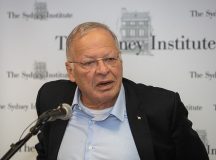Celine Touboul is the co-Executive Director of the Economic Cooperation Foundation (ECF), an Israeli policy-planning think-tank. Celine leads ECF’s policy efforts for Gaza stabilization. She argues for five measures needed to undermine Hamas and return the Palestinian Authority to Gaza.
It is unfortunate that an awareness of the need to reset Israel’s Gaza policy has only emerged in the wake of a new round of confrontation in the Strip. Within that context, it seems Israel’s Defence Minister Benny Gantz and US officials agree that a strategy aimed at consolidating a Gaza ceasefire requires empowering the Palestinian Authority (PA) and facilitating its involvement in Gaza reconstruction and stabilisation. This is a significant departure from the previous Israeli government’s approach of considering the PA an irrelevant player, seeking to deepen the divide between the West Bank and Gaza, and providing the pro-Hamas Qatar with the opportunity to play a role in Gaza stabilisation, even at the cost of strengthening Hamas.
Notwithstanding a decade’s worth of contradictory evidence, Israeli government policy was to view Hamas control as stabilising Gaza. Today, it finally seems that Egypt – which since the 2014 war in Gaza has tried to lead an alternative strategy, based on a gradual return of the PA to manage Gaza – is no longer alone. This is a key shift that creates an important opportunity for a coordinated Israeli-Egyptian-American effort. Its centerpiece is the now often repeated advocacy of ‘strengthening the PA’ and ‘bring the PA back to Gaza’.
Translating these slogans into an action plan is the obvious challenge.
The discussion on the stabilisation of Gaza currently revolves primarily around the question of how to avoid the diversion of materials and funds to Hamas, and how to design a mechanism that will guarantee that Hamas does not benefit from reconstruction. The Gaza Reconstruction Mechanism (GRM), created after the 2014 war, and operating under instructions from both Israel and the PA, is not to be blamed for Hamas’s rearmament. While there is room for improvement, any upgrading of this mechanism must not only prevent diversion of material, but further facilitate – rather than hinder – Gaza reconstruction and development, while enhancing the role of the PA and its contribution to this effort. If this is to be the logic, upgrading the monitoring mechanism will be an important piece of the puzzle of Gaza stabilisation. Yet, that alone does not suffice in changing the balance of power between Hamas and the PA.
Five Measures
Strengthening the PA and facilitating its return to managing Gaza requires Israel to act on five sets of measures.
First is enhancing the prospects of success (as no player will agree to take the lead on an effort that is doomed to failure). To that end, Israel should ease restrictions on movement of goods and persons in and out of the Strip, and support large-scale projects, including the planning, construction and operation of a seaport, all under PA supervision and in a manner that addresses Israeli security needs.
Second, as a more visible and active PA role will require power-sharing arrangements between Fatah and Hamas, Israel should support, rather than veto, the formation of a technocratic consensual government that will be responsible for administrating Gaza civilian affairs under PA leadership. Subject to agreed measures ensuring that Hamas has no access to funds managed by this government, Israel should encourage donors to support these efforts and assist in the government’s transparent management of those funds.
Third, the PA should be reassured that as long as Hamas and other Gaza factions have not been disarmed and that the PA does not have adequate security capacities in Gaza, Israel will not hold the PA responsible for any third party breach of the ceasefire.
Fourth, the PA cannot be expected to cooperate with a strategy that improves conditions in Gaza alone. This proposed comprehensive approach must thus see to it that West Bankers are also better off (regardless of its Gaza dimension). The steps required do not necessarily challenge the ideological bounds of the new Israeli government, as none of the coalition members object to those directly related to West Bank quality of life, stability and security. Such policies include an entire range of measures to remove impediments for – and actively support – Palestinian economic development; enhancing the PA’s governance capacities; ending IDF incursions into Area A, which undermine the legitimacy and hence effectiveness of the PA security forces; dealing effectively with radical and violent streams within the settler community in both the West Bank and Jerusalem, and more.
Fifth, prevent all extremist provocations in and around Jerusalem’s holy sites, strictly adhere to the Status Quo, restore Jordan’s role, and end all evacuations of Palestinians from their homes in the city. Whereas this is essential for much broader reasons, this also deprives Hamas of any claim to represent Palestinians in the city. Moreover, continued provocations in Jerusalem are bound to make it harder for the PA to uphold its commitment to non-violence and cooperation with Israel, and will make its position in Gaza unsustainable.
There is no simple answer to the current volatility of the Gaza ceasefire. The PA’s involvement remains a prerequisite for a stabilisation effort that holds some promise of long-term stability. This is the case not only for those who wish to preserve the viability of a two-state solution but also for those in the Israeli government who do not wish to be dragged into reoccupying Gaza, and thus understand the need for a Palestinian entity to govern Gaza affairs, preferably one that is not Hamas. The recent conflict made it clear that empowering the PA to play that role will require Israel to grasp that developments in the West Bank and Jerusalem now affect Gaza stability and vice-versa.




































